27 March 2017: Professor Aphichat Chamratrithirong, Director of Mahidol Migration Center, Institute for Population and Social Research, with Associate Professor Sureeporn Punpuing proposed the concept of replacement migration in the demographic transition theory by presenting a paper on The “Regional Demographic Transition towards Peace and Prosperity: A Case Study of Thailand and its Neighboring Countries”, at The International Conference on Prospects for Peace and Prosperity in the New Age, organized by Department of Diplomacy and International Relations, Tamkang University, Taiwan.
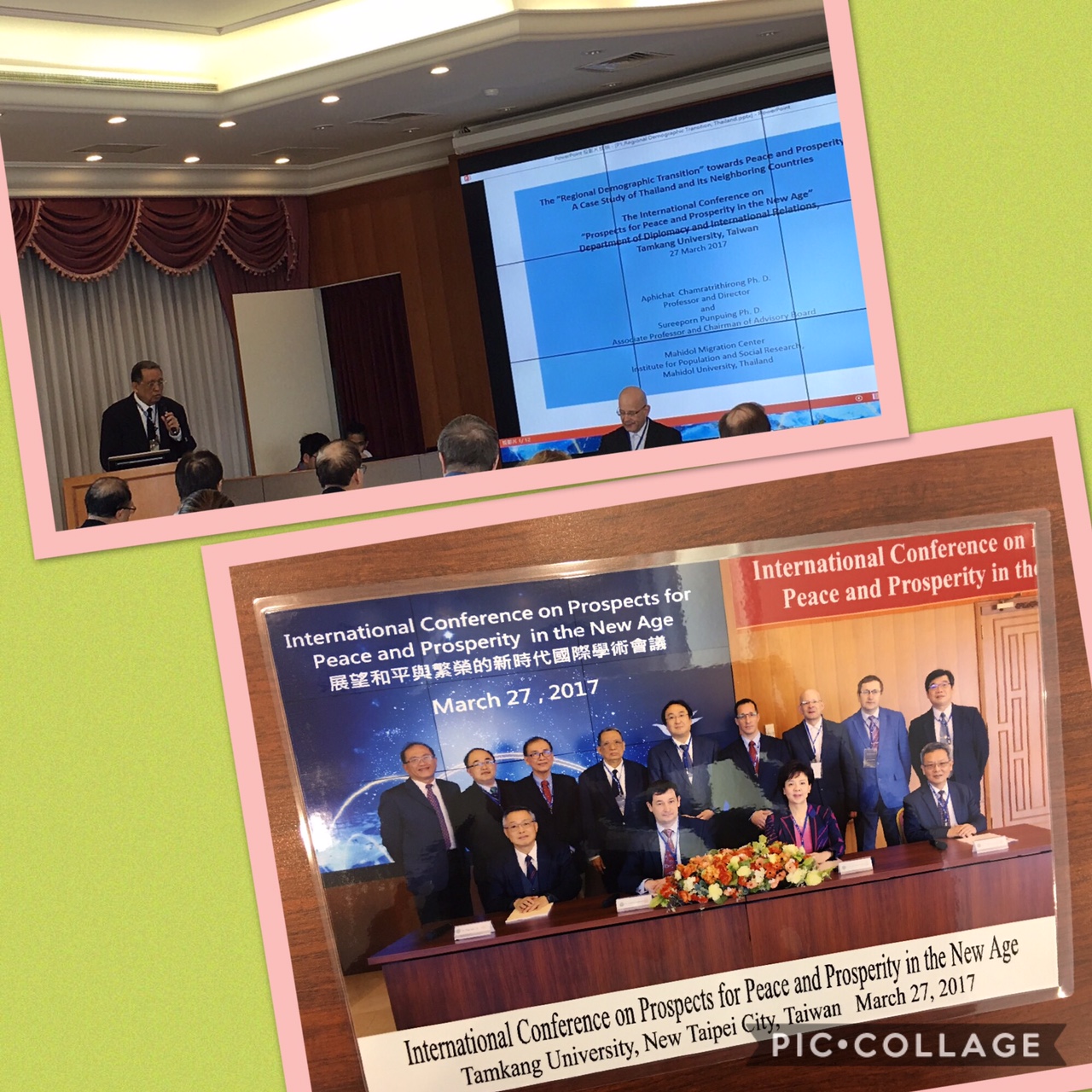
The “Regional Demographic Transition” towards Peace and Prosperity:
A Case Study of Thailand and its Neighboring Countries
The International Conference on
“Prospects for Peace and Prosperity in the New Age”
Department of Diplomacy and International Relations,
Tamkang University, Taiwan
27 March 2017
Aphichat Chamratrithirong Ph. D.
Professor and Director Mahidol Migration Center
Institute for Population and Social Research, Mahidol University, Thailand
and
Sureeporn Punpuing Ph. D.
Associate Professor and Chairman of Advisory Board
Mahidol Migration Center
Institute for Population and Social Research, Mahidol University, Thailand
Abstract
At the end of 2015, at least six percent of the Thai population (or about ten percent of the Thai labor force) were cross-border migrant workers from the three neighboring countries of Thailand, namely, Myanmar, Cambodia and Lao PDR. The demographic advantage of having these migrants is to compensate for the shortage of Thai labor resulting from the fertility decline in Thailand during the last 30-40 years. The replacement of low-wage labor by foreign migration is, in the short-term, probably the most efficient demographic solution, unlike the conventional replacement of a new generation by fertility. Though low-wage migrants can raise regional competitiveness and can sustain short-term economic growth, the long-term aim of Thailand to shift to a knowledge-based economy would be delayed. Making the minimum wage for cross-border migrant workers equal to their Thai counterparts is not only humane, but also will help lessen the disadvantage of Thai lower-skilled workers, and shift the workforce to a more advanced stage of productivity. The necessity, possibility and implications of such a migration policy for long-term sustainable development and promoting an innovative economy in Thailand are the focus of this research.
The proposition of this paper is that the process of replacement migration within the framework of the proposed “Regional Demographic Transition” (RDT) is and will progress favorably in Thailand. We will demonstrate that Thailand has been following a trajectory of the country’s demographic, economic and political evolution since completing the demographic transition (vital transition) to critically-low fertility at the end of the 1980’s. Subsequently, the country faced an increasing shortage of lower-skilled labor as it transitioned into an ageing society. Eventually, the economic demand for non-Thai “replacement migration” outweighed the socio-cultural resistance. International pressure also played a role in stimulating the need for migration management which includes not only the regulation of migrants, but also, eventually, the protection and promotion of migrant workers. In this phase of the RDT, the host country becomes enlightened on integration of migrants, and could achieve an equilibrium through a series of political adjustments. The authors project that, because of the country’s demographic force, Thailand will ultimately be successful in achieving peace and inclusive prosperity, not only for itself but also for its neighbors in the sub-region.
The “Regional Demographic Transition” towards Peace and Prosperity: A Case Study of Thailand and its Neighboring Countries
I. Introduction: The Regional Demographic Transition
Fertility decline to a very low level is a relatively recent phenomenon in many countries; not only the majority of developed countries but also in an increasing number of developing countries. In Asia, the critically low replacement populations, as seen in Japan, Taiwan, Korea, Singapore, China and Thailand, are ageing rapidly and, accordingly, are suffering from a shortage of labor in the younger age groups. The responses of these countries to this demographic threat are, therefore, of great interest to researchers. As a case study, this paper focuses on the response of Thailand to its country’s demographic changes. The investigation takes into account the unique geographical configuration of Thailand in being surrounded by three lower-income neighboring countries, with long and open borders, and where the stages of demographic transition are so much different. Thailand underwent fertility decline for a long time whereas its neighbors still experience population growth of a certain magnitude. It is strategically important how and whether the sub-region will balance these demographic discrepancies, e.g., by way of sending and receiving population to and from each other, and whether replacement migration is seen as a win-win opportunity.
In this paper we hypothesize that Thailand will eventually follow what we call the “Regional Demographic Transition” (RDT). The RDT not only refers to fertility and mortality, but also to cross-border migration among countries in the sub-region. Key issues for the transition in this regard, as presented in Figure 1, are how a country experiences the decline to critically low fertility, how it responds to the shortage of labor, and how it adapts to becoming an ageing society. Unless there is extreme control of international borders, the flow of migrants from lower-income to a higher-income neighbor is almost impossible to prevent. The economic demand for (usually low-skilled) labor is so strong that it outweighs any socio-cultural friction that results from an influx of foreigners. As the number of migrants increases, the host country government will have to institute measures to manage migration, regulations and services to ensure legal documentation of migrants, and, eventually, active protection and promotion of migrant rights. Related issues are how best to integrate the migrants into the society, eradication of illegal migration and, ultimately, reaching a balance of population movements in the sub-region for peace and prosperity for both sending and receiving countries.
The RDT is an optimistic perspective based on the proposition that the demographic and economic forces for collaboration are more powerful than potential political conflict from the mixing of populations. The time frame of the RDT is long-term and open, and there will be political shifts as countries adjust to the demographic dynamics. Increased regional collaboration and mutual promotion will also be the basis of peace and prosperity. Although the case of Thailand is unique and the country can benefit from positive supporting cultural elements, the application of RDT in other countries and sub-regions is believed to be driven by the same demographic forces. Whether this can be generalized elsewhere, has to be explored by future research.
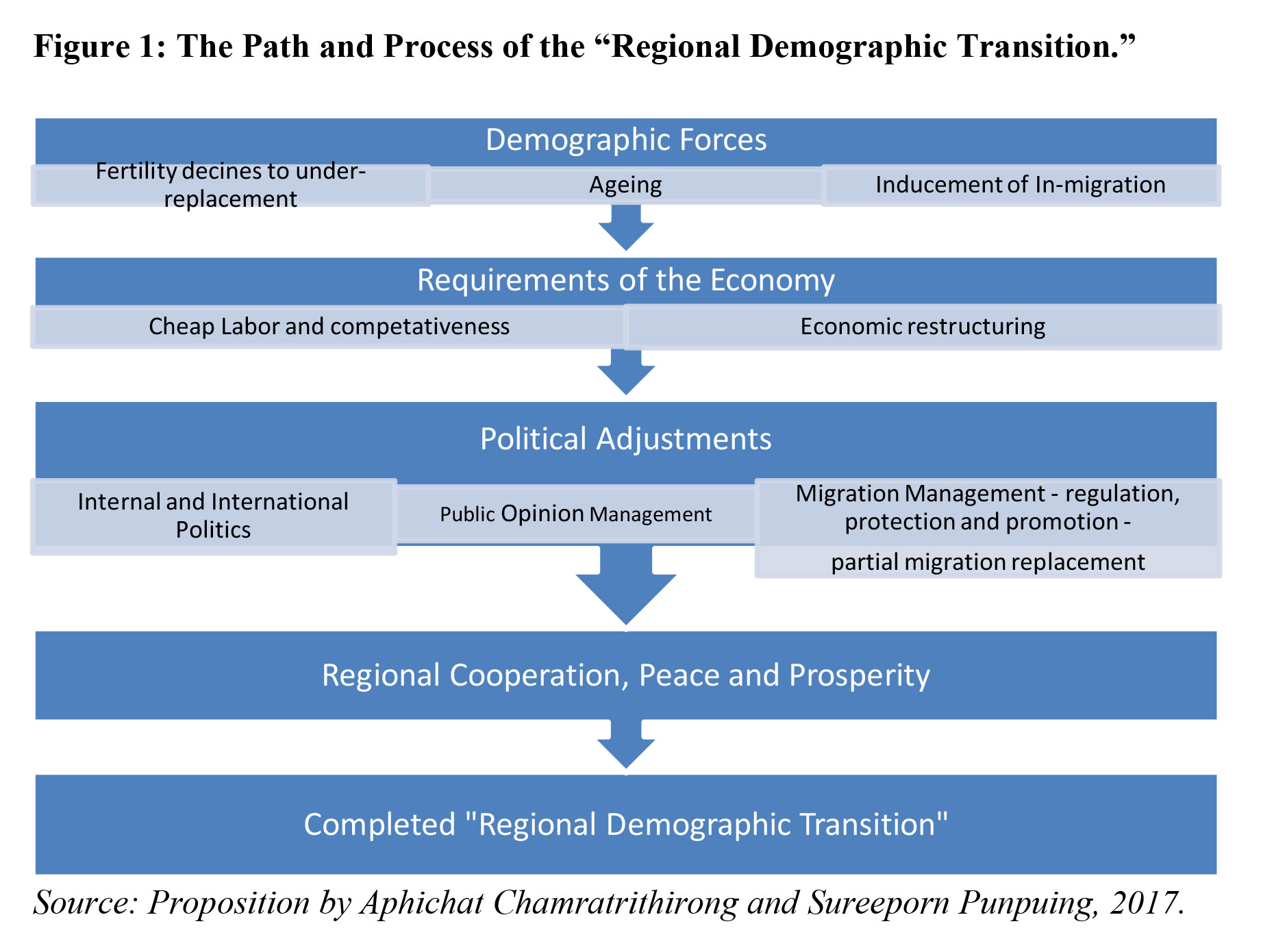
II. The Demographic Forces
Fertility declined rapidly in Thailand during the last 40 years from a high TFR of more than 6.0 before 1970 to the replacement level of 2.1 around the end of the 1980’s (Hirschman et al., 1994). Fertility continued to the under-replacement level of 1.6 or lower at present (according to United Nations Population Division). Benefiting from the low fertility and the low dependency ratio, the demographic dividend which gave the country the opportunity to attain peak economic growth, was achieved in 2009 when the labor force population reached its highest proportion of the total, or about 68 percent (Wongboonsin et al., 2007). Since then, the country started the transition toward an ageing society; now the proportion of population over 60 years is 16 percent of the total and will continue to increase steadily.
The demographic dividend in Thailand was short-lived as the shortage of younger workers started to impact negatively on Thailand’s labor-intensive industries. The insufficiency of Thai labor forced employers to look to the lower-income neighboring countries of Myanmar, Cambodia and Lao PDR for workers, regardless of whether they were legal or illegal migrants. Migration from these three countries has accounted for the large majority of foreign workers in Thailand (Table 1). In 2010, the Thai national census estimated the number of migrants from these countries to be 2.1 million (although the actual number was thought to be significantly higher). Others estimated the number of migrants to be 2.5 million in 2009 (Huguet and Chamratrithirong, 2011) and 3.7 million in 2013 (United Nations, 2013). Using primary and secondary sources of data with the survey techniques of repeated enumeration, the number of migrants from these three countries in Bangkok alone was estimated to be 600,000 in the period around 2014 (Chinvarasopak et al., 2013). The most recent (December 2015) estimate of the total migrants (regular and irregular) from these countries throughout Thailand was at least 3.5 million migrants and their accompanying dependents (Institute for Population and Social Research, 2016). Still this number probably excludes the hidden floating population which may be of considerable size. If we take the rough estimate of the population size of foreign migrant workers from these three countries of 4 million (which includes the hidden population) that total would account for about 6 percent of Thai population or about 10 percent of the Thai labor force.
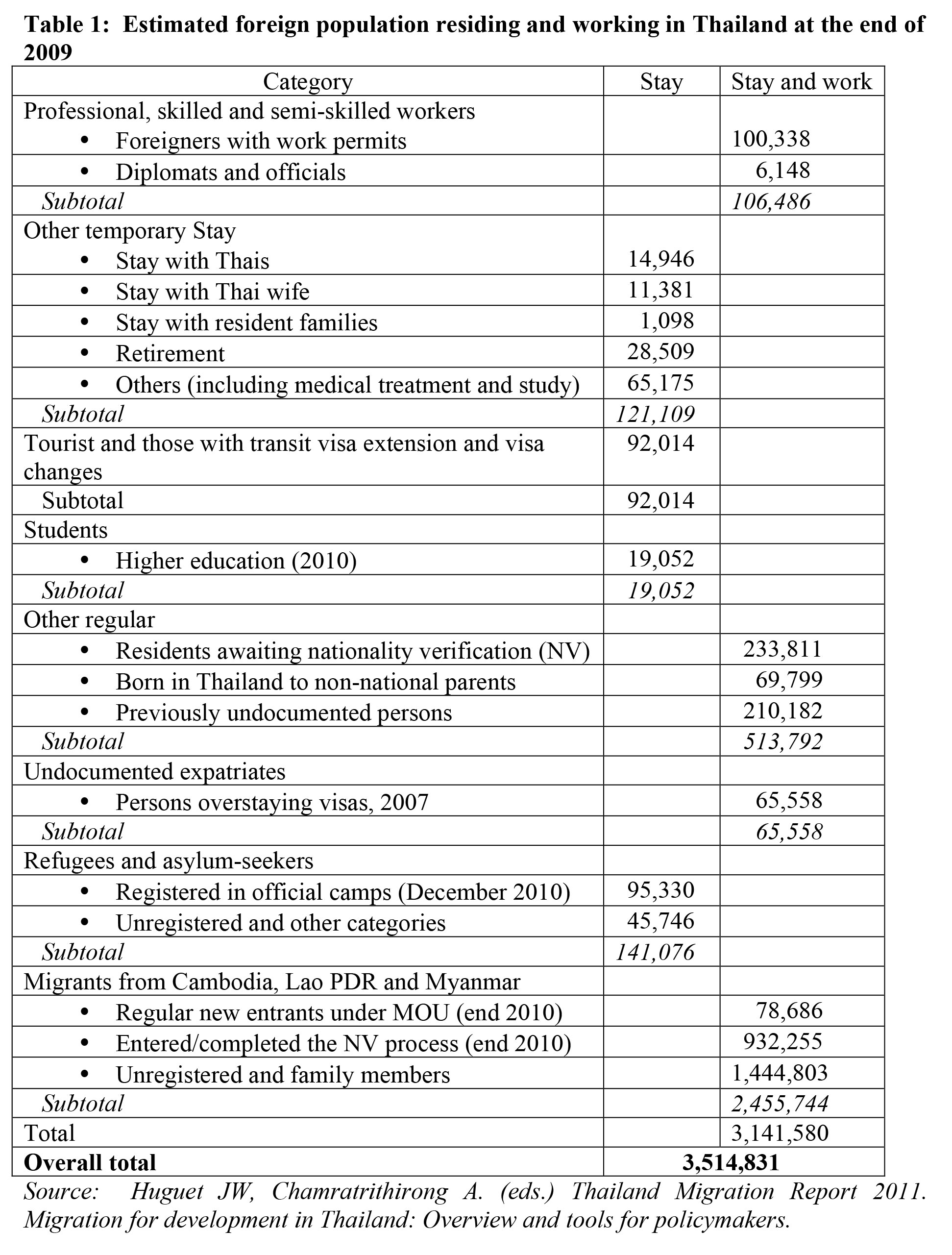
According to forecasts by the United Nations on the nature of replacement migration in a low-fertility society, migration will continue (with phenomenal number) until there is an equilibrium between the demand and supply for labor. (United Nations, 2000; Keely, 2002). However, this equilibrium is theoretical since there is usually a limit to tolerance of a host society once the number of migrants becomes significantly large and assimilation is low (as currently witnessed in many countries of Europe). A question is, what is the balance between a country’s nationalism (i.e., preserving the national identity) and the fear of a declining indigenous population? The proposition of this paper is that in the long run the demographic force will win. Politics will adjust itself. Although native Thais still vastly outnumber migrants from the three sending countries, the projected demand for labor implies that the proportion of migrants in the Thai labor force could reach 20 percent or more in the near future. Among selected countries in East and South-east Asia, Thailand ranks the fifth among 17 countries by proportion of migrants of the total population (Table 2). Higher proportion of migrants in a country like Thailand is not impossible.
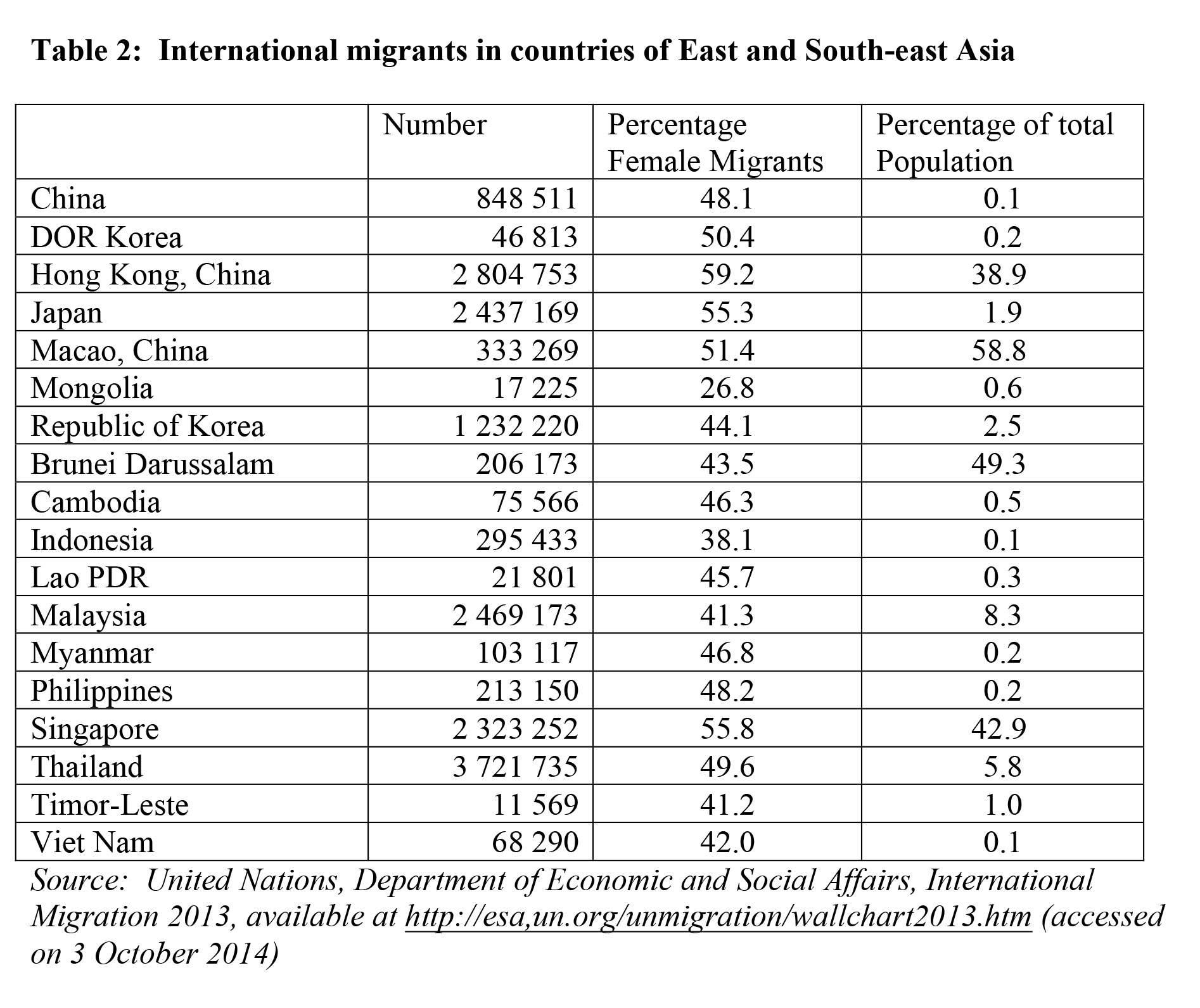
III. Requirements of the Economy
The history of demand for migrant labor from Thailand’s three, lower-income neighbors can be divided into two phases. The first phase probably started in the 1990’s or even before, and involved the demand for low-skilled migrants to work in the so-called three D’s jobs (“dirty, dangerous and demeaning”) which most Thais refused to do. Examples are the fisheries sector, seafood processing, certain harmful forms of agriculture, manual labor industries and construction (see Table 3). The economy of Thailand at that time still depended on undocumented cheap labor to promote the competitiveness of exports. Undocumented migrant labor could be paid less since they were not covered by Thai labor laws and protections, and that increased demand by employers for foreign labor, especially in border provinces where control of migration was lax. The political atmosphere just then also favored the border provinces who could politically state their demand for migrant workers and could keep the wage lower than the Thais.
The contribution of these migrant workers during that time has been calculated by economists. It was found that, in the period before 1996, as high as six percent of Thailand’s GDP was attributed to migrant labor (Sussangkarn, 1996). By contrast, in 2005 it was estimated that migrant workers accounted for only 0.2 percent of the Thai GDP (Pholpirul and Rukumnuaykit, 2010). Furthermore, employment of migrants depressed wages of Thai labor by as much as 4.3 percent in the agricultural sector and 2.4 percent in
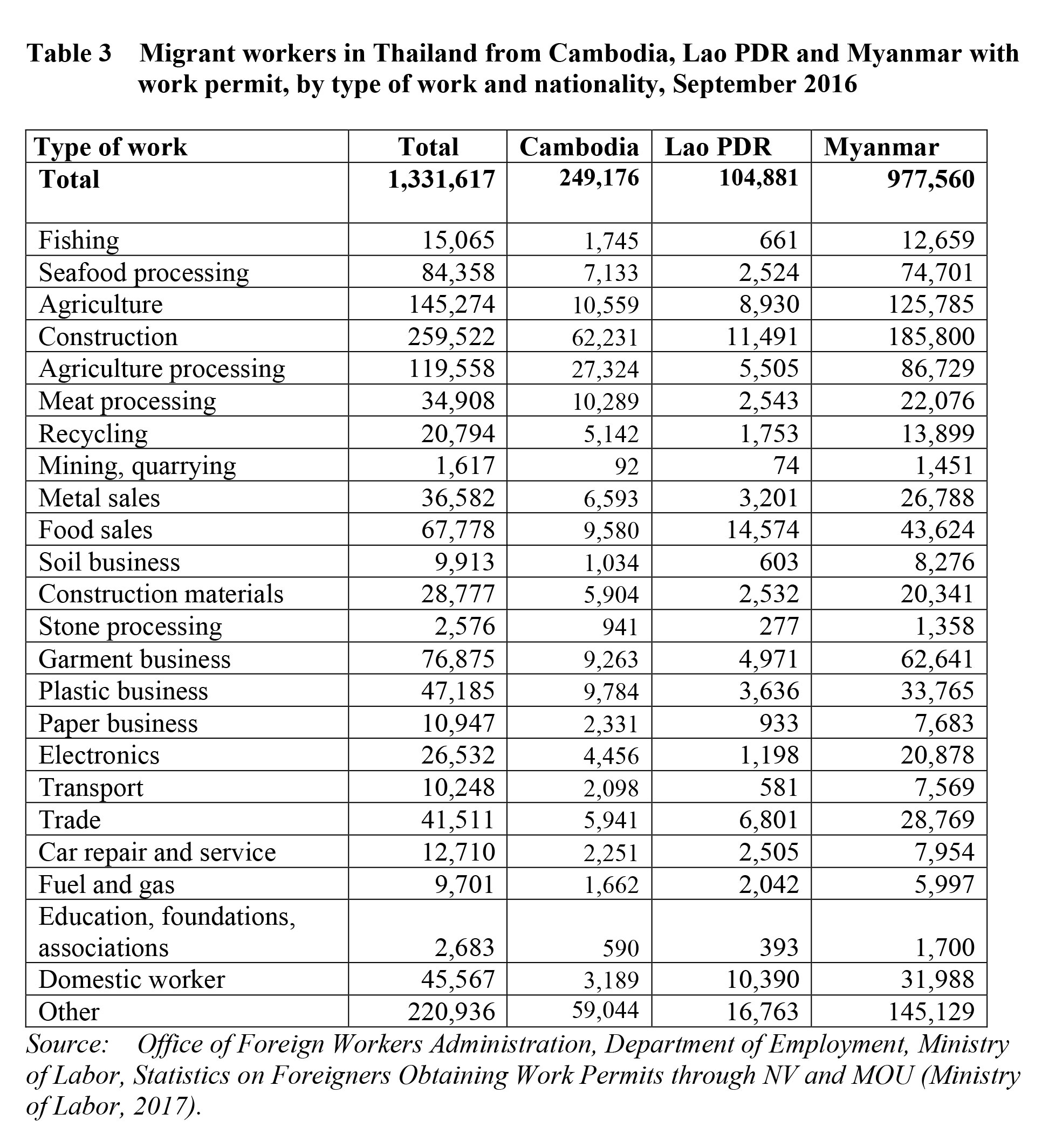
the manufacturing sector (Pholpirul and Kamlai, 2014). While employment of migrants raises productivity in the aggregate, this was accomplished by emphasizing labor-intensive methods rather than expansion of investment in technology to modernize the workforce and production (Pholpirul and Kamlai, 2014).
Many sectors continued to rely on labor-intensive production despite the fact that the government wanted to see the country modernize production methods to keep pace with the developed world. More recently, a survey of firms that employed migrants from Myanmar, Cambodia and Lao PDR revealed that such employment discouraged employers to invest in innovation (Pholpirul and Rukumnuaykit, 2013). Although using migrant workers could help maintain cost competitiveness in the short run, the effect of reduced R&D investment tended to impede improvements in productivity and weaken global competitiveness in the long run.
Consequently, in the second phase of the economic policy of managing demand of migrant workers in Thailand (i.e., in early 2012 after the country’s flood disaster of 2011) the government started to shift to a higher level of skilled-labor migrants by regulating import of migrants more carefully. The goal of the government to achieve an innovative economy (as per the current national economic policy of Thailand 4.0) places greater priority on the quality of migrants, including providing labor protections and benefits, equal to what their Thai counterparts enjoy.
During this period, internal as well as international politics were involved in the policy formulation and implementation process. Nevertheless, strong “replacement migration” still persisted. The next section discusses migration management.
IV. Political Adjustments
Public Opinion Management
If hyper-nationalism increases in a society, then cross-border migration will be perceived as an existential threat to the country. There is (exaggerated) fear of migrant violence and crime, drug smuggling and human trafficking, conflicts targeting specific nationalities, border disputes, discrimination, and proliferation of hate crimes. These issues easily become political (as currently witnessed in Europe and the US), and lead to mismanaged policies or inflammatory media outlets.
A research on the attitudes of the Thai people toward migrant workers indicated that some Thais have a prejudice against displaced persons and especially irregular migrants from Myanmar because the Thais have, as researchers put it, “fear of the unknown” (Sunpuwan and Niyomsilpa, 2014). These fears are not normally present among mainstream Thais, but are created and spread by others who seek to gain some benefit from xenophobia.
The impact of cross-border migration is perhaps one of the most widely researched topics, mainly because it is commonly misunderstood in public discourse. News broadcasts and media reports often portray migrants in a negative light. Sunpuwan and Niyomsilpa (2014) have found that about half of respondents in the Northern region of Thailand perceive migrants more as a problem than an opportunity, citing concerns about migration leading to a rise in crime and a threat to personal security. Irregular or unregistered migrants were seen as a bigger problem and threat. In general, however, the fear of the unknown is not all widespread among Thais. The Thai public are not totally against migrants especially if they are legal migrants (Sunpuwan and Niyomsilpa, 2014). The similarity of the cultures of the four Buddhist countries probably helps not to make the issue too problematic.
International Pressure
The influx of migrants from Myanmar to Thailand since the early 1990s was initially due to the political conflict and instability in Myanmar. As of 2013, there were 127,038 displaced persons registered in the ten shelters along the Thailand-Myanmar border, which 78,575 persons were registered with the United Nations High Commissioner for Regugees-UNHCR (Huguest, 2014). It is also important to note that these asylum-seekers are not allowed to work in Thailand (Huguet and Chamratrithirong, 2012). The management of these nine shelters had started the international politics and pressure to Thailand from the UN communities as to how the migrants are threated.
At the same time, Thailand’s rapid economic development during the same period attracted a large number of migrants from Myanmar, as well as Lao PDR and Cambodia. The majority of these people are economic migrants, who are “pulled” by the demand of the labor market in Thailand. While migrants are vulnerable to abuse, exploitation, and trafficking, the continued influx of low-skilled workers suggests that the risk-benefit calculation for migration to Thailand is favorable. (Punpuing et al., 2006; Chalamwong et al., 2012; Hugo, 2012). This stream of migration is always problematic as far as the international perspective is concerned. As foreign governments, EU, USA, and United Nations agencies continue to expose abuse of migrant labor in Thailand, the impact on exports from Thailand (e.g., seafood) have been threatened (USA, 2016). For example, in 2014, the U.S. put Thailand on Tier 3 (the worst human trafficking offenders) on country’s trafficking records. Thailand had to respond by regulating migrants and showing good governance of management of migration quite immediately. In 2016, the United States decided to remove Thailand to a better position of Tier 2 Watch List of those that still deserve special scrutiny. The government of Thailand continues working hard on every means to push itself to even a better position. The international pressures certainly work positively to lead Thailand to a better migration management. This shows that demographic force is the underlying driving power for political and social changes. It works also through international pressure.
Migration Management
When discussing regularization of migrants to Thailand, we should distinguish between ‘legal entry’ and ‘legal work.’‘Legal entry’ refers to migrants entering Thailand with a proper passport and visa, which show a permission to stay with limited duration of stay. The Immigration Division of the Ministry of Interior is responsible for processing entry of foreigners to Thailand. ‘Legal work’ means that migrants who want to work in Thailand need to apply for a work permit from the Ministry of Labor. The work permit indicates type of the job, location of the workplace and duration of the permitted job.
Migration management in Thailand was developed in four schemes since 1992 (Table 4). Earlier, the Thai government had been somewhat slow to develop policies to manage low-skilled migration, and had not created a clear, direct and holistic long-term policy to manage irregular migration. Since the 1990s, the first scheme that the government implemented is a ‘registration’, which based on the cabinet resolution for each round of registration. It was started in 1992, and then modified to cover workplace and type of industries. Irregular migrants and their employers have taken advantage of an almost yearly amnesty program initiated by the government (Sciortino and Punpuing, 2009). The last round of registration (through the cabinet resolution) in 2012, allowed the registration of 167,881 in 2012 migrant workers. During an earlier registration period in 2011, 1.25 million migrant workers were registered (Ministry of Labor, 2017).
In addition to the work permit registration, in 2004 the Thai government asked all irregular cross-border migrants and their dependent to register their residential status through the TR 38/1. This results in 1.28 migrants registered their names and address in Thailand (Ministry of Labor, 2004).
The second scheme of migration management by Thailand is through bi-lateral MOU with Thailand’s neighbors which allows legal entry and permission to work. However, the bi-lateral MOU process is encountering many challenges because it is costly, time consuming, overly bureaucratic, and overwhelmed with corrupt recruitment agencies working with officials on both sides of the border. Despite being signed in 2003, the MOU with Myanmar has only become operational in 2009. By the end of September, 2016, the number of cross-border migrant workers under entered Thailand under the MOUs was 365,785 (Ministry of Labor, 2017).
A third scheme developed by the government to address irregular migrants is the nationality verification (NV) process, which aims to regularize the irregular (but registered) migrants by allowing them to acquire legal status through the issuance of temporary passports of up to 6 years in validity. This scheme started in 2010 and, upon completion of the NV process, migrants receive rights, including social security, work accident compensation, and health insurance, and freedom of unrestricted travel within Thailand and between Thailand and the home country. However, the NV process tends to be long, overly complicated, unregulated and expensive. Migrant rights groups and critics are not very optimistic that the majority of migrant workers in Thailand will be able to access basic rights to which they should be entitled following this process. Therefore, large groups of low-skilled labor will remain unprotected. Recent statistics suggest that a majority of migrant workers, although becoming fully regularized, have less access to official health services than ever before. The dialogues between the government with the NV process and the right groups are at least open and the compromise can happen one day. Recently, by the end of September, 2016, there were 965,832 cross-border migrant workers pass the NV, and remain working and living in Thailand (Ministry of Labor, 2017).
As for the fourth scheme, in 2014, the government of the National Council for Peace and Order (NCPO) implemented a One-Stop Service (OSS) center, where all migrant workers including their dependents registered their residents. This results in there was 1.63 million migrants registered during June-October, 2014 (Ministry of labor, 2017). Collectively, as of September, 2016, the total number of regular cross-border migrant workers under the MOU, NV and OSS schemes was approximately 2.96 million, but likely, the actual number of regular and irregular migrants from the three Thailand neighboring countries is believed to be probably much higher (Ministry of Labor, 2017).
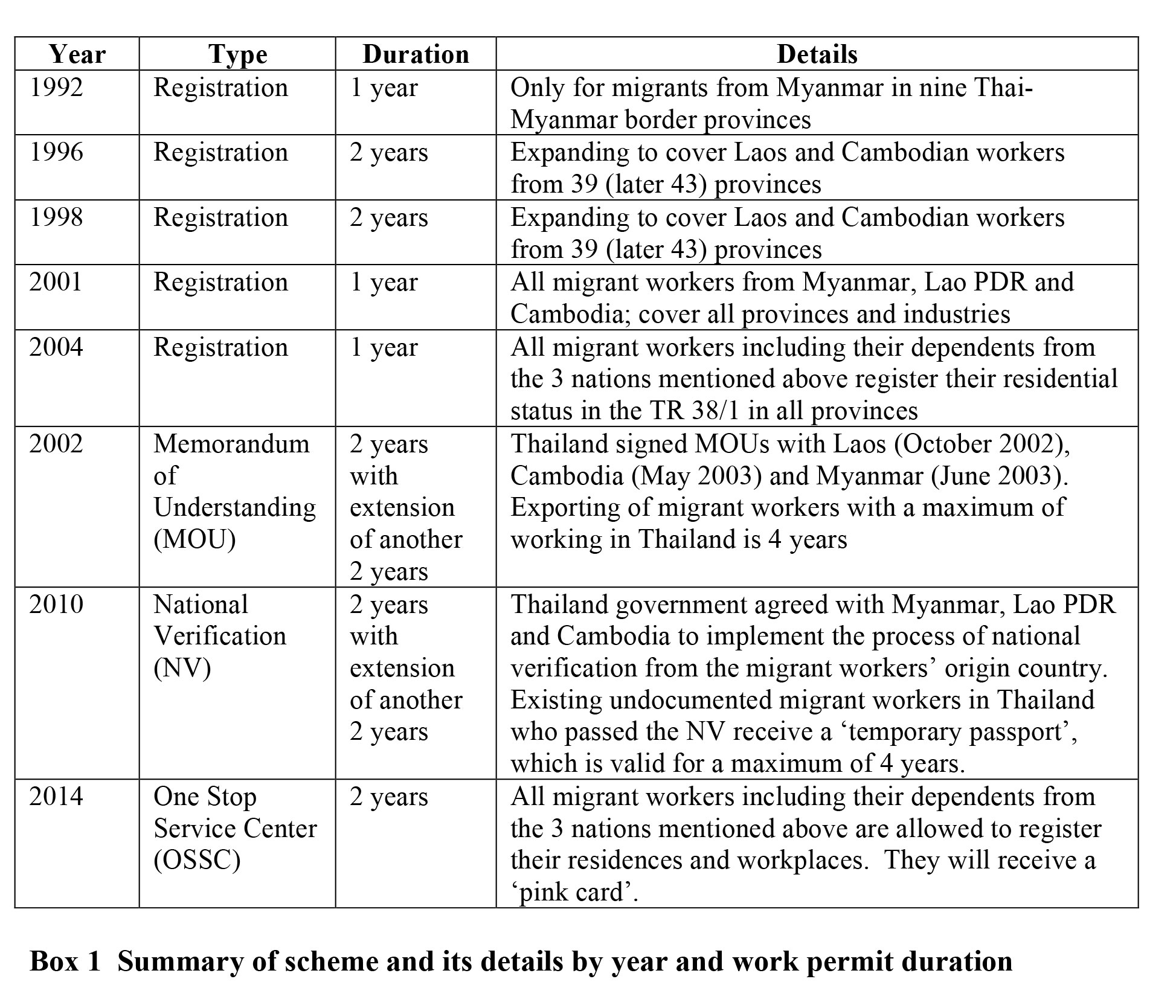
b. Protection and Promotion
In general, the governments are responsible for formulating laws on decent work and social protections, and regulating activities involved in migration facilitated by recruiters and employers to ensure that their actions are in line with the law. In addition, Civil Society, trade unions and even the federations of industries or the chambers of commerce can play key complementary roles in creating an enabling environment to protect the rights of the migrants and prevent exploitation.
International and national labor unions have the potential to advocate for the rights of migrant workers and recruit migrant workers to join trade unions.However, at present, in Thailand, the inclusion of migrant workers in trade unions is rare due to various reasons from both the trade unions and migrant workers.For example, in order to protect migrants from employment exploitation, a written contract between migrants and employers or recruitment agencies needs to be signed. The employment contract should include a description of the job, site of employment and duration of the contract, basic and overtime remuneration, regular working hours, rest days and holidays, transportation to the destination country and place of employment and return, employment injury and sickness compensation and emergency medical care, valid grounds for termination of the contract, mechanism for settling disputes, and non-cash compensation and work related benefits (ILO, 2007). However, in practice, problems arise when the contract is not adhered to.The recruitment agencies often demand payments that are excessive and not specified in the contract. The migrants also complained about being pressured to sign the contract before knowing what types of job that they will obtain, lack of contract enforcement, and not being given a copy of the employment contract (Huguet, 2015).
With enough experiences of the four schemes of migration management mentioned earlier, although the disputes between workers and employers are still evident, the protection mechanism for migrants is already installed in the system.With strong leadership and the effective secretariat of the government, it is optimistic that the migrant protection platform will be more operative in the near future.
Although, there are both positive and negative impacts of international migration at different levels, international migration has played an important role as a contributor to the socio-economic improvement in both the country of origin and destination in many parts of the world. To support the positive development outcomes of migration, and to concur with the international standard of human right protection especially the ASEAN Declaration on the Protection and Promotion of the Rights of Migrant Workers, there is a need to invest in decent labor and social protections, health and education benefits, ensuring a fair recruitment process and practices, and empowering migrants to participate in local society.
A situation analysis before 2012 on health system strengthening for migrants in Thailand revealed that barriers include the lack of legal identification and health cards, the time consuming nature of a hospital visit, the need to travel long distances, language barrier, and fees charged.More worrying was evidence suggesting that fully legal workers could be falling into gaps in enforcement of social security laws, which was technically leaving them without any health care at all for at least three months after their registration (Chamchan, 2012).Fortunately, this three month gap is now already fulfilled.In addition, the government’s new pro-natal policy which is just currently announced by the Prime Minister of Thailand, may spill over for the benefits of migrant children as well. The health and education of migrant children would soon be seen not as a ‘cost’ but as an ‘investment’ for migrants and for Thailand as a whole.Providing prevention and health promotion will be seen as being more cost-effective than treating migrants with complicated health and quality conditions.
Furthermore, the Thai government has a policy of ‘education for all’, which means all children in Thailand have a right to attend school regardless their or their parents migration status.In practice, the negative attitude of the school/teachers, or limitations of the time of the child’s migrant parents may limit access to school. Civil Society is finding ways and processes to help migrant children access education (Institute for Population and Social Research and Asian Institute of Technology, 2014).By using health issues and children’s education as examples, it is being convinced by all that Thailand’s migration policies ought to be framed around principles that look toward a more healthy, open economy and a society with integrated social justice to serve the public good.With the concurrence with the international standard, the proposals are more and more accepted and implemented by the government.
c) Partial replacement migration
Thailand has experienced continuing fertility decline for more than three decades, the replacement of labor by migration is the most efficient demographic solution. The conventional replacement of a new generation by fertility would take at least 25 years (one generation) to fill gaps in the Thai labor force. Convincing parents to come back to high fertility is also a very difficult job. By migration, Thailand we can fill the gap within a matter of a few years. However, “replacement migration” is a process that will become phenomenal if it is left unattended. The replacement of population of low fertility country by migration will end up with almost a replacement of a near total population (Keely, 2002).
Cross-border migration is seen as creating an economic dilemma in the Thai labor market. The problem is that many Thai workers do not yet have the capacity to take high-skilled jobs while they refuse (or cannot compete for) lower-status jobs which migrant workers are willing to take. Importing low-wage migrants can contribute to immediate economic growth, because short-term investment in labor-intensive industries can boost Thailand’s regional competitiveness. However, the process of changing to a new industrial structure will take considerably longer. That said, the informal and irregular migrants are important during the economic restructuring and adjustment period. The dilemma is that, in the long run, the economic restructuring and increase in productivity will be delayed and the country’s goal of a knowledge-based economy might never be attained. The government has to intervene to promote and invest in human resource development, rather than having the short-sighted view of labor as a fixed production unit, and not as a path to higher potential.
That is to say, the country has no other choice except to manage migration well, upgrading migrants to be of equal status as the native labor force. This includes the management of employers and the upgrading of the economic structure to an innovative and knowledge based economy and discarding the labor intensive industry as much as possible and as early as it could be.
The issues of cross-border migration, particularly an elimination of the 3Ds jobs, among the irregular migrants should be urgently addressed.There should be stricter enforcement of the safety code and increased use of appropriate machinery and equipment. Moreover, the appropriate international standard work-hour and compensation code must be adhered to, with minimum daily wage of 300 baht, and all the benefits provided to the cross-border migrants being equal to Thai workers.
It should be stressed that regulations have to be strengthened primarily among the employers, and not just among the migrants. As for the migrants, they have to be promoted and empowered. They should be able to form organizations and unions, as their collective voice, where they can also regulate themselves. All these measures can reduce misunderstanding and promote good governance. In the end, any country cannot avoid the situation of ‘no migration.’ Instead, the goal should be what we call “harmony in diversity.’ To reach this end, the integration or assimilation of migrants needs to be implemented.
V. Regional Cooperation, Peace and Prosperity
New international approaches to managing migration (including regulations, protection and promotion) are needed in order to maximize its benefits and opportunities.The assumption that migration is strictly a national issue to be handled unilaterally by one government is no longer valid. Ideally, in order to ensure the best possible outcomes of migration, the national policies and regional, sub-regional and bilateral agreements on migration, guided by international frameworks on human rights and labor standards, should be integrated with national or country development priorities (Huguet, 2015). In addition, international, national, and regional migration policy reform is also required to meet the challenges of the 21st century.With this direction and successful implementation of the regional cooperation, peace and prosperity in the region will emerge.
VI. Conclusion
There are no illegal labor migrants.There are only illegal employers.Treating migrant workers as well as indigenous workers with strong enforcement of the law will improve the quality of the labor force in general.Migration management involves three schemes: regulation, protection and promotion.With these three dimensions of good management and the minimum wage standardized, the flow of migrants will adjust naturally, and gradually correspond to the real demand under the country’s goal of restructuring the economy to the higher level of production and services. The current government policy of innovative economy is the correct way to respond to the demographic change in Thailand.
The challenging role of the government is how to enhance the country’s capacity of technological application to create value-added productivity. Promoting social protections, including the minimum wage for cross-border migrant workers, will help reduce the disadvantage of the local low-skilled workers, and move everyone toward a higher level of productivity. This will not induce more irregular migrants because industry will no longer be allowed to hire underpaid migrants.
As data and information are now available, good research is currently conducted and, importantly, migration management is becoming more and more effective, Thailand can attain the aim of a technology-based and knowledge-based economy. Increase in the migrants’ skill will be a win-win situation both for destination country and the migrants’ home country. The regional prosperity will follow. It is optimistic that there will be complete enforcement of law, step by step, focusing on the employers, not primarily on the migrants.
This paper has proposed that the process of replacement migration within the framework of the proposed “Regional Demographic Transition” (RDT) would progress favorably in Thailand. We demonstrated that Thailand had been following a trajectory of the country’s demographic, economic and political evolution since completing the demographic transition (vital transition) to critically-low fertility at the end of the 1980’s. We outlined that the country faced an increasing shortage of lower-skilled labor as it transitioned into an ageing society.
It was found that the economic demand for “replacement migration” outweighed the socio-cultural and even political resistance. International pressure played major role in putting pressure on Thailand to come up with migration management which included not only the regulation of migrants, but also, the protection and promotion of migrant workers. We believed that in this phase of the RDT, the host country became enlightened on integration of migrants, and could achieve an equilibrium through a series of political adjustments. We project that, because of the country’s demographic force, Thailand would ultimately be successful in achieving peace and inclusive prosperity in this respect, not only for itself but also for its region.
References